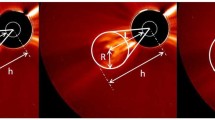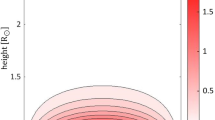Abstract
Analysis of observations from both space-borne (LASCO/SOHO, Skylab and Solar Maximum Mission) and ground-based (Mauna Loa Observatory) instruments show that there are two types of coronal mass ejections (CMEs), fast CMEs and slow CMEs. Fast CMEs start with a high initial speed, which remains more or less constant, while slow CMEs start with a low initial speed, but show a gradual acceleration. To explain the difference between the two types of CMEs, Low and Zhang (2002) proposed that it resulted from a difference in the initial topology of the magnetic fields associated with the underlying quiescent prominences, i.e., a normal prominence configuration will lead to a fast CME, while an inverse quiescent prominence results in a slow CME. In this paper we explore a different scenario to explain the existence of fast and slow CMEs. Postulating only an inverse topology for the quiescent prominences, we show that fast and slow CMEs result from different physical processes responsible for the destabilization of the coronal magnetic field and for the initiation and launching of the CME. We use a 2.5-D, time-dependent streamer and flux-rope magnetohydrodynamic (MHD) model (Wu and Guo, 1997) and investigate three initiation processes, viz. (1) injecting of magnetic flux into the flux-rope, thereby causing an additional Lorentz force that will destabilize the streamer and launch a CME (Wu et al., 1997, 1999); (2) draining of plasma from the flux-rope and triggering a magnetic buoyancy force that causes the flux-rope to lift and launch a CME; and (3) introducing additional heating into the flux-rope, thereby simulating an active-region flux-rope accompanied by a flare to launch a CME. We present 12 numerical tests using these three driving mechanisms either alone or in various combinations. The results show that both fast and slow CMEs can be obtained from an inverse prominence configuration subjected to one or more of these three different initiation processes.
Similar content being viewed by others
References
Amari, T. J., Luciani, F., Mikić, Z., and Linker, J.: 2000, Astrophys. J. 529, L49.
Andrews, M. D. and Howard, R. A.: 2000, Space Sci. Rev. 95, 147.
Antiochos, S. K., DeVore, C. R., and Klumchuk, J. A.: 1999, Astrophys. J. 510, 485.
Chen, J. and Krall, J.: 2003, J. Geophys. Res., 108, A11, 1410.
Chen, J. R., Howard, A. Brueckner, G. E., Santoro, R., Krall, J., Paswaters, S. E., St. Cyr, O. C., Schwenn, R., Lamy, P., and Simnett, G. M.: 1997, Astrophys. J. 490, L 191.
Gosling, J. T., Hildner, E., MacQueen, R. M., Muroe, R. H., Poland, A. I., and Ross, C. L.: 1976, Solar Phys. 48, 389.
Guo, W. P., Wu, S. T., and Tandberg-Hanssen, E.: 1996, Astrophys. J. 469, 944.
Liu, W., Zhao, X. P., Wu, S. T., and Scherrer, P. H.: 2003, Proc. ISCS 2003 Symposium, Solar Variability as an Input to the Earth’s Environment, ESA SP 535, 459.
Low, B. C.: 1990, Ann Rev. Astron. Astrophys. 28, 491.
Low, B. C. and Zhang, M.: 2002, Astrophys. J. 564, L53.
MacQueen, R. M. and Fisher, R. R.: 1983, Solar Phys. 89, 89.
Plunkett, S. P., Vourlidas, A., Šimberová, S., Karlický, J., Kotrč, P., Heinzel, P., Kupryakov, Y. A., Guo, W. P., and Wu, S. T.: 2000, Solar Phys. 194, 371.
Ramshaw, J.D.: 1983, J. Comput. Phys. 52, 592.
Shafranov, V. D.: 1960, Soviet Phys. JETP 37, 775.
Sheeley, N. R. Jr., Walters, J. H., Wang, Y.-M., and Howard, R. A.: 1999, J. Geophys. Res. 104, 24739.
St. Cyr, O. C., Burkepile, J. T., Hundhausen, A. J., and Lecinski, A. R.: 1999, J. Geophys. Res. 104, 12493.
St. Cyr, O. C. et al.: 2000, J. Geophys. Res., 105, 18169.
Švestka, Z.: 2000, Space Sci. Rev. 95, 135.
Tandberg-Hanssen, E.: 1995, The Nature of Solar Prominence, Kluwer, Dordrecht.
Tousey, R.: 1973, Adv. Space Res. 13, 713.
Wang, H. M., Spirock, T. J., Qiu, J., Ji, H. S., Yurchyshyn, V., Moon, Y.-J., Denker, C., and Goode, P. R.: 2002, Astrophys. J. 576, 497.
Wu, S. T. and Wang, J. F.: 1987, Comp. Method Appl. Mech. Eng. 64, 267.
Wu, S. T., Guo, W. P., and Wang, J. F.: 1995, Solar Phys. 157, 325.
Wu, S. T., Guo, W. P., and Dryer, M.: 1997, Solar Phys. 170, 265.
Wu, S. T., Guo, W. P., et al.: 1997, Solar Phys. 175, 719.
Wu, S. T., Guo, W. P. Burlaga, L. F., and Michels, D.: 1999, J. Geophys. Res. 104, A7, 14,789.
Wu, S. T., Guo, W. P., Plunkett, S. P. Schmieder, B., and Simnett, G. M.: 2000, J. Atmos. Solar-Terr. Phys. 62, 1489.
Zhang, M., Golub, L., DeLuca, E., and Burkepile, J.: 2002, Astrophys. J. 574, L97.
Author information
Authors and Affiliations
Rights and permissions
About this article
Cite this article
WU, S.T., Zhang, T.X., Tandberg-Hanssen, E. et al. Numerical Magnetohydrodynamic Experiments for Testing the Physical Mechanisms of Coronal Mass Ejections Acceleration. Sol Phys 225, 157–175 (2004). https://doi.org/10.1007/s11207-004-2568-7
Received:
Accepted:
Issue Date:
DOI: https://doi.org/10.1007/s11207-004-2568-7




